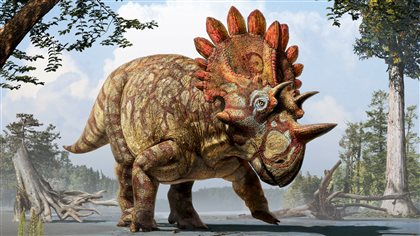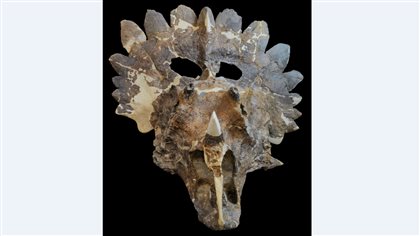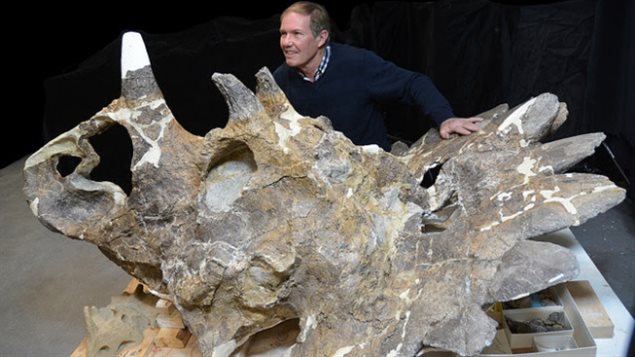A huge skull excavated on the edge of the Rocky Mountains in western Canada is evidence of a new species of horned dinosaur from the Triceratops family.

The 68-million-year-old specimen is called Regaliceratops peterhewsi, but was nicknamed Hellboy for the difficulty in getting it out of very hard rock, and for the two stubby horns that make it look like a comic book character of the same name.
“It was a plant-eater and it had a very large skull and it would have had a very bulky body,” says Donald Henderson, curator of dinosaurs at the Royal Tyrrell Museum of Palaeontology in the province of Alberta. “We estimate it was probably four to five meters long and it would have weighed 1.5 to two tons.
Listen
‘An array of spines…and a frill’
“The head is massive. It’s 1.6 metres long and it’s got an array of spines around the edge of a frill which sticks out the back of the skull. It’s got two small stumpy horns over the eyes and it had a long horn coming off the top of its nose,” says Henderson.
The horns and frill were probably for display for species recognition, says Henderson comparing it to the different horns now sported by various species in Africa. He suspects Hellboy was a very social animal.
Hellboy similar to long-extinct dinosaur
“It looks very similar to a type of horned dinosaur that went extinct several million years previously. It’s almost as if this horned dinosaur was trying to re-evolve a similar body shape and face,” says Henderson.
The other remarkable thing about Hellboy is that the skull is three-dimensional. Most dinosaur remains are flat.
While southeastern Alberta is rich in fossils, only three have been found in the western part of the province and paleontologists think there may be many more.
Specimen airlifted by helicopter
Hellboy was seen sticking out of a cliff beside a cliff. Scientists had to wade across the river carrying their equipment to dig the skull out. And they had to make sure nothing fell into the river because the area is a crucial habitat for Alberta’s iconic fish, the bull trout.
Once it was freed, the specimen had to be airlifted out by helicopter, taken to the museum and the rock chipped away from the skull. It took ten years from its discovery to its finally going on display yesterday, and being written up in the journal, Current Biology. “The head is truly amazing,” says Henderson.
Museum attracts tourists, researchers
The Royal Tyrrell Museum has one of the largest dinosaur displays in the world. It is not only a tourist attraction but a centre for research that attracts scientists from around the world. It is situated in Drumheller and designed to blend in with the surrounding badlands environment.







For reasons beyond our control, and for an undetermined period of time, our comment section is now closed. However, our social networks remain open to your contributions.